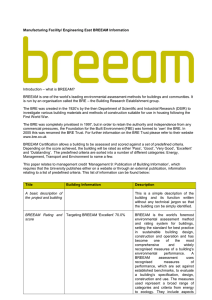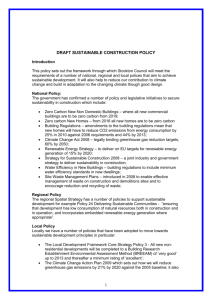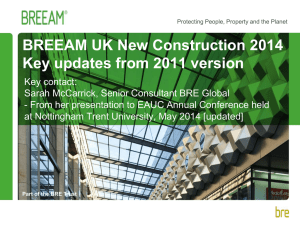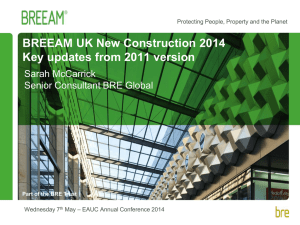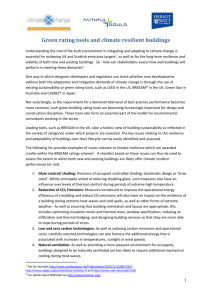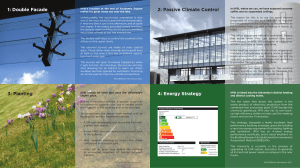Assessing carbon emissions in BREEAM
advertisement
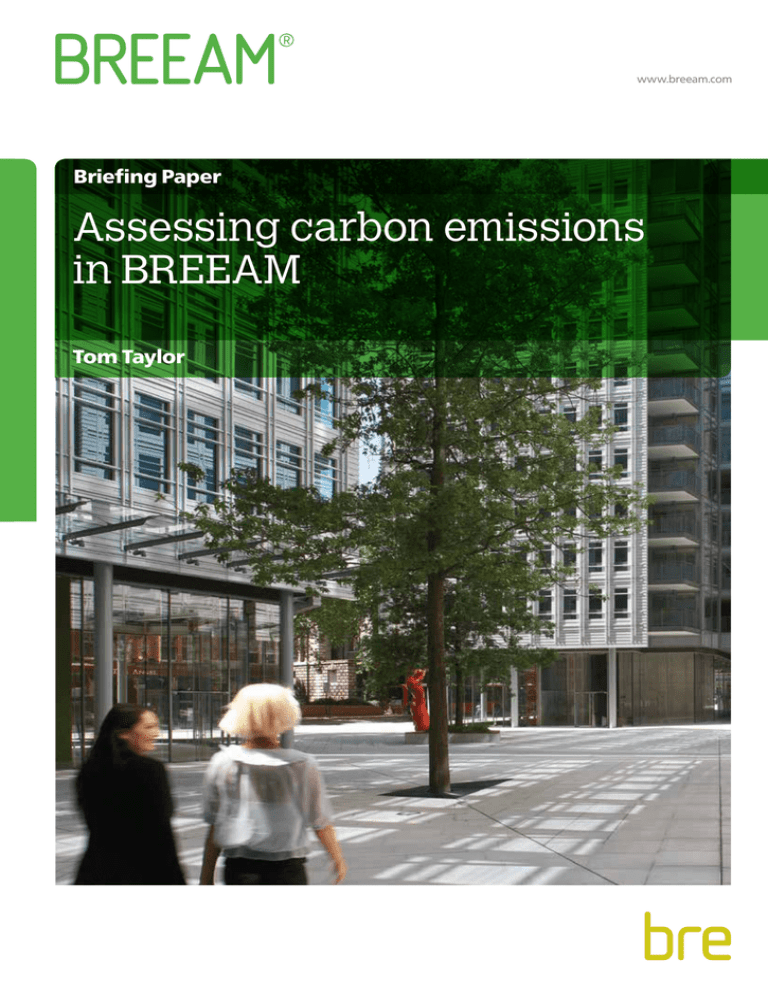
www.breeam.com Briefing Paper Assessing carbon emissions in BREEAM Tom Taylor 2 Often the forerunner of regulation, and continually challenging the industry to go beyond standard practice and innovate, BREEAM has been driving reductions in building energy consumption and associated CO2 emissions since the first scheme was launched in 1990. A recent analysis of assessment data showed that BREEAM assessed buildings achieve an average 22% reduction in CO2 emissions, and over the next five years, BRE has committed to work with industry to deliver over 9,000 certified buildings with emissions savings in excess of 900,000 tonnes of CO2. This briefing paper gives an overview of how the schemes and assessment methodologies have evolved in response to changes in industry knowledge and practice, how they might develop in future, and how BREEAM assessed buildings perform in terms of predicted carbon emissions savings. BREEAM’s approach to energy and carbon savings Elemental approach The first BREEAM schemes encouraged reductions in CO2 emissions through simply rewarding good practice and the implementation of individual energy saving measures. The triple metric approach has subsequently been implemented in the International New Construction scheme, and the Home Quality Mark – a new consumer focussed UK standard for assessing new homes. Further life cycle stages Whole building assessment The basic elemental assessment approach was replaced in 1998 by the adoption of a proprietary whole building assessment tool, ‘ESICHECK’. The change to whole building modelling was a significant development for BREEAM, providing a more robust methodology capable of quantifying predicted carbon emissions savings at a whole building level. Alignment with Building Regulations Whilst the first BREEAM schemes focussed on New Construction, BRE Global now operate a number of schemes in the UK and internationally, covering different life cycle stages of the built environment, including: –– BREEAM Communities for large scale development projects and masterplanning –– BREEAM In-Use for existing non-domestic buildings in-use –– BREEAM Refurbishment for domestic and non-domestic building fit-outs and refurbishments In 2003, the Energy Performance of Buildings Directive (EPBD) was adopted, requiring member states of the European Union (EU) to adopt a whole building calculation methodology for the assessment of carbon emissions. This approach was implemented in the 2006 version of Building Regulations Part L, and as a result, the UK Building Regulations effectively mirrored the existing BREEAM calculation methodology with the adoption of a whole building National Calculation Method. Since this change, BREEAM New Construction schemes in the UK have aligned with this Building Regulations methodology to avoid unnecessary burdens for design teams and awarded credits through recognising improvement beyond the regulatory minimum performance requirements for CO2 emissions. BREEAM Communities provides a framework for considering the issues and opportunities that affect sustainability at the earliest stage of the design process for large developments. Credits are awarded for developing an energy strategy, and implementing recommendations that achieve CO2 reductions over a baseline set by regulatory requirements. Introduction of the triple metric Credits are awarded in the BREEAM Refurbishment and Fit-out scheme for demonstrating an improvement over the performance of the existing building, rather than linking to a regulatory baseline. The ‘triple metric’ approach introduced in BREEAM UK New Construction 2011 awards credits based on performance against energy demand and primary energy parameters, in addition to the CO2 emissions parameter that has always been assessed. This change was introduced to encourage a fabric first approach to design through ensuring fabric performance is considered before seeking to meet any demand as efficiently as possible, through the primary energy metric, and finally offsetting CO2 emissions where possible through the installation of low or zero carbon technologies. The BREEAM In-Use scheme is used to measure actual operational performance and benchmark this across a range of issues, providing a framework for continual optimisation of performance. A Part 2 (Building Management) BREEAM In-Use assessment, requires an evaluation of operational energy consumption, and associated CO2 emissions, based on actual metered energy consumption data. 3 Future assessment The assessment of energy and carbon emissions in BREEAM will continue to evolve to ensure that the assessment methodologies remain technically robust and relevant. One of the main aims of the energy strategy moving forward is to strengthen the links between schemes covering different life cycle stages, with a particular focus on the relationship between the New Construction and In-Use schemes, and associated opportunities for addressing the ‘performance gap’. Changing regulatory requirements, and in particular the mandatory EU requirement for near zero energy buildings will influence the assessment of buildings at the design and construction stage and could mean that there will be very limited scope for requiring performance beyond mandatory minimum standards. This could potentially mean that the focus of assessment will shift to ‘unregulated’ energy, a whole life cycle approach including embodied carbon, and improving the accuracy and verification of predicted operational energy consumption and associated CO2 emissions. Other external drivers like advances in technology and changes in the design, procurement, construction and management processes will have implications for the delivery of BREEAM as a whole, and in particular the assessment of energy consumption and CO2 emissions. 28.17% Performance of buildings The energy assessment methodology used in the New Construction schemes means that it is possible to quantify predicted savings for New Construction projects by comparing predicted actual emissions with regulatory baseline performance. This comparison has been undertaken using data collected from UK New Construction 2011 assessments with the analysis demonstrating significant CO2 emissions savings for a range of building types, as shown in Figure 1. The above analysis also showed a clear link between the CO2 emissions savings and overall BREEAM rating, with higher BREEAM ratings seeing a steady increase in CO2 reductions, as shown in Figure 2. Whilst average CO2 savings for BREEAM assessed buildings are currently in the region of 22%, the BREEAM methodology strongly aligns with the zero carbon agenda and encourages buildings to aspire to this level of design performance. At the same time, BREEAM seeks to ensure quality through an accessible, holistic and balanced measure of environmental impacts. This holistic approach is essential, since this helps to ensure that decisions are not made in isolation without considering all potential impacts. This means that is addition to encouraging high levels of energy performance, different assessment categories reward best practice performance in other areas that may be impacted by the energy strategy including indoor air quality and thermal comfort. COP21 Climate Pledge 23.73% 22.68% 20.76% 18.98% 19.22% The above analysis has formed the basis of BRE’s climate pledge made in advance of the COP21 climate negotiations in Paris (December 2015). BRE’s pledge is a commitment to work with industry to deliver over 9,000 BREEAM certified buildings with predicted emissions savings in excess of 900,000 tonnes of CO2 (compared to regulatory minimum performance requirements) between 2016 and 2020)(2). Average CO2 emissions savings 60 Education Healthcare Office Other Prisons Retail Average % reduction in CO2 emissions by building type Figure 1: Average % reduction in CO2 emissions by building type Source: BRE Global: Improvement in CO2 emissions by building type, BREEAM rating, and region of assessment11 50 40 30 20 10 0 Outstanding Excellent Very Good Good BREEAM Rating Figure 2: Average CO2 emissions savings associated with different BREEAM ratings (1)Total number of projects with data available: 273. Emissions savings for regulated energy only, based on comparison with Building Regulations Part L 2010. (2)These figures are based on the number of post construction certificates predicted to be issued over this period, and an assumption that certified buildings will achieve the same average relative improvement over the regulatory baseline as has been achieved for buildings assessed against the 2011 New Construction scheme. BREEAM (Building Research Establishment’s Environmental Assessment Method) is the world’s first sustainability rating scheme for the built environment. Through its application and use, BREEAM helps clients to measure and reduce the impacts of their buildings and in doing so, create higher value, lower risk assets that are better for people and the environment. © BRE Global Ltd 2015 Permission is granted for this report to be distributed only in its entirety, without amendment, and with copyright attribution to BRE Global Ltd. Over the last 25 years BREEAM has evolved and grown to reflect advances in science, technology, policy and business. BREEAM is the world’s leading sustainability assessment method for buildings and communities, with more than 530,000 certificates issued and a global reach encompassing more than 70 countries. Find out more about BREEAM’s achievements over the last 25 years by visiting our dedicated microsite www.breeam.com/breeam25 Every effort has been taken to ensure the accuracy of this report but no warranty is made in respect of any conclusions or opinions expressed herein. BRE Global Ltd’s liability in respect of this report and any reliance thereupon is disclaimed and BRE Global shall have no liability to third parties to the extent permitted in law. BRE Global Bucknalls Lane Watford United Kingdom WD25 9XX T+44 (0)333 321 8811 Ebreeam@bre.co.uk www.breeam.com BRE Trust The BRE Trust uses profits made by BRE Group to fund new research and education programmes, that will help it meet its goal of ‘building a better world together’. The BRE Trust is a registered charity in England & Wales: No. 1092193, and Scotland: No. SC039320. 2199-HB © BRE Global Ltd 2015 BREEAM is a registered trade mark owned by BRE (the Building Research Establishment Ltd. Community Trade Mark E5778551). The BREEAM marks, logos and symbols are the Copyright of BRE and are reproduced by permission.
